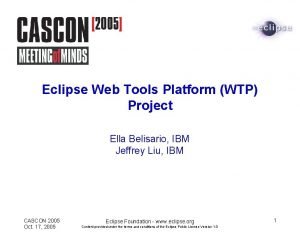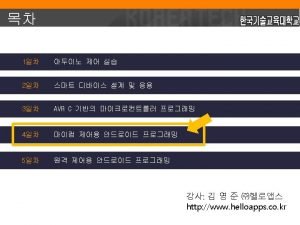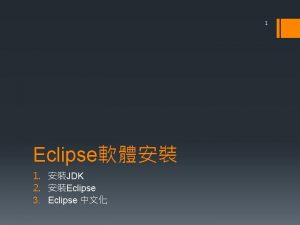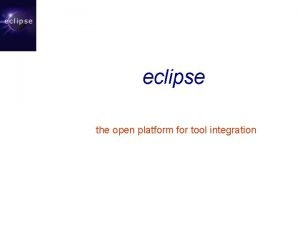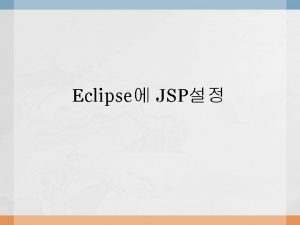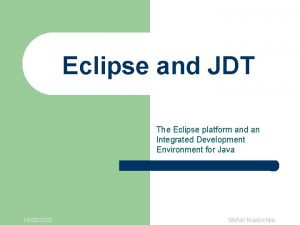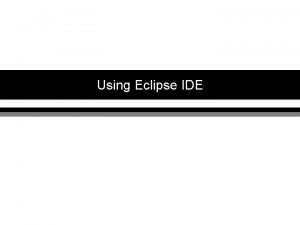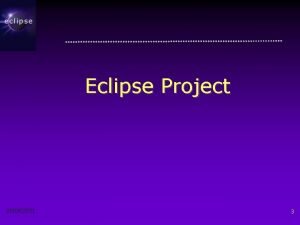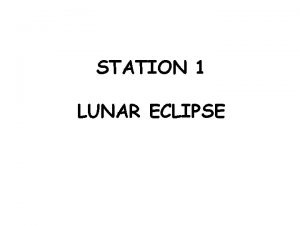Using Eclipse What is Eclipse The Eclipse Platform


























- Slides: 26

Using Eclipse

What is Eclipse? • The Eclipse Platform is an open source IDE (Integrated Development Environment), created by IBM for developing Java programs. • Eclipse is now maintained by the Eclipse Foundation, not IBM. • A free copy can be downloaded at: – http: //www. eclipse. org/

IDE Workbench • Eclipse is based on a flexible “Work. Bench” concept. • The workbench is where all the IDE features come together in a common set of icons, menus, and views.

Eclipse Workbench Package Explorer – where your Project, Packages and Classes are created Console – where your program output is displayed and inputs are accepted Source Code Editor – where you enter the Java code for your program

Projects • A Project enables you to operate in the Eclipse Work. Bench • Before you can create any Java programs, you must first create a Project

Creating Your Project • First - Select: File>New>Java Project – (Or Click the Java Project Icon)

Creating Your Project (cont’d) • • Next: Enter PACE as the Project Name Select “Use default JRE …” Select “Use project folder as root …” Click Finish

Packages • Packages help you organize your Java source code • Packages are like folders for your Java code • Before we can enter our Java code, we have to create a package to hold our code

Create Your Package • Option 1: – File > New > Package • Option 2: – Right Click on the PACE Project Name – Select: New > Package • Option 3: – Click the Package ICON in the toolbar just below the menubar

Create Your Package (cont’d) • Enter a package name that represents your program – Start with a lowercase – No spaces or special symbols – If you use multiple words, capitalize each additional word – Put Pkg at the end of your package name Example: hello. World. Pkg • Click Finish when done

Classes • Classes are where the work of your program is done • Typically, you’ll have a separate class for each logical component of your program Example: a Climate Control system might have classes for: – – Thermometer Thermostat Cooling system Heating system • For most of our early programs we will only create one class for the main program • For our final Spring project, we will create a program with multiple classes

Creating a Class • Option 1: – Click on your package name – Select: File>New> Class • Option 2: – Right Click on your package name – Select: New > Class • Option 3: – Click the “New Class” ICON in the toolbar just below the menubar

Creating a Class • Enter a Class Name that represents your program – Start with an uppercase – No spaces or special symbols – If you use multiple words, capitalize each additional word Example: Hello. World • Select the checkbox next to “public static void main” • Click Finish when done

Saving your code • Notice the top of your editor tab where your class name is shown. The “*”indicates it has not been saved. • Press CTRL-S to save your file. CTRL-S saves your file and compiles it in one step.

Running your Program • From the menubar, select: Run> Run As> Java Application. • After the first time, you can simply click the Run icon in the toolbar just below the menubar to run it again

Check your Output in the Console – where your program output is displayed and inputs are accepted

Exporting your Java Code • Export enables you to save your Java code to a file in the filesystem • In industry, typically you would export your code to a JAVA Archive (JAR) file • This enables you to then distribute your code, along with all resources and images, to other users • In our class, we will use a standard archive (ZIP) file

Exporting your Java Code • Option 1: – Click on your package name – Select: File > Export … • Option 2: – Right Click on your package name – Select: Export …

Exporting your Java Code (Cont’d) • In the Export window, under General, select Archive File • Click Next

Exporting your Java Code (Cont’d) • Be sure the checkboxes for your class files are selected as well as the checkbox for your package • Click Browse and locate the entry for your thumbdrive in the resulting window, then open the thumbdrive and enter a filename. When you click Open, the drive and filename will appear in this window • Click Finish when done

Exporting your Java Code (Cont’d) • When you clicked Browse in the prior window, the window below appears and will enable you to locate your Removable thumbdrive. • Double-click the thumbdrive icon, then enter a File name in which to export your class • Click Open when done • You will return to the prior window

Importing your Java Code • Import enables you to retrieve your prior work from your thumbdrive and load it into Eclipse • First, create a PACE Project using the procedures previously reviewed

Importing your Java Code (Cont’d) • Option 1: – Click on the PACE Project name – Select: File > Import … • Option 2: – Right Click on the PACE Project name – Select: Import …

Importing your Java Code (Cont’d) • Next, under the General category, click Archive File • Click Next

Importing your Java Code (Cont’d) • Click Browse to locate the file you previously exported to your Thumbdrive • Make sure your code will be imported into the PACE project folder • Click Finish when done

Importing your Java Code (cont’d) • After importing your package, you will typically see a red X in the left margin indicating a problem with the package definition • Click the red X • In the resulting window that appears, choose the 1 st option Move <classname>. java to <package. Name>
 Eclipse web tools
Eclipse web tools Eclipse web tools platform
Eclipse web tools platform Differentiate between lunar eclipse and solar eclipse
Differentiate between lunar eclipse and solar eclipse Exo solar lunar
Exo solar lunar Embedded linux development using eclipse
Embedded linux development using eclipse Thể thơ truyền thống
Thể thơ truyền thống Từ ngữ thể hiện lòng nhân hậu
Từ ngữ thể hiện lòng nhân hậu Sự nuôi và dạy con của hổ
Sự nuôi và dạy con của hổ Diễn thế sinh thái là
Diễn thế sinh thái là Thế nào là hệ số cao nhất
Thế nào là hệ số cao nhất Vẽ hình chiếu vuông góc của vật thể sau
Vẽ hình chiếu vuông góc của vật thể sau Lp html
Lp html Phép trừ bù
Phép trừ bù Lời thề hippocrates
Lời thề hippocrates Vẽ hình chiếu đứng bằng cạnh của vật thể
Vẽ hình chiếu đứng bằng cạnh của vật thể Glasgow thang điểm
Glasgow thang điểm đại từ thay thế
đại từ thay thế Quá trình desamine hóa có thể tạo ra
Quá trình desamine hóa có thể tạo ra Cong thức tính động năng
Cong thức tính động năng Khi nào hổ con có thể sống độc lập
Khi nào hổ con có thể sống độc lập Thế nào là mạng điện lắp đặt kiểu nổi
Thế nào là mạng điện lắp đặt kiểu nổi Các châu lục và đại dương trên thế giới
Các châu lục và đại dương trên thế giới Các loại đột biến cấu trúc nhiễm sắc thể
Các loại đột biến cấu trúc nhiễm sắc thể Bổ thể
Bổ thể Biện pháp chống mỏi cơ
Biện pháp chống mỏi cơ độ dài liên kết
độ dài liên kết Thiếu nhi thế giới liên hoan
Thiếu nhi thế giới liên hoan

